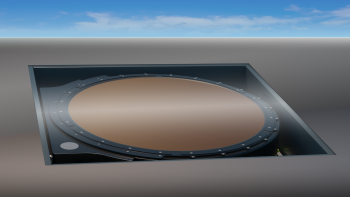- Terminals provide broad channel bandwidth communications in multiple frequency bands to deliver top performance
- VICTS antenna solution outperforms ESAs on power, thermal dissipation, throughput, high latitude operation, weight and reliability
- Conformal design results in a radome that is flush with the aircraft skin

#thenewscompany : ThinKom has secured a major production contract for an airborne, multi-band, conformal antenna solution to support a military partner. Initially funded as a development contract, the offering takes advantage of ThinKom’s patented Variable Inclination Continuous Transverse Stub (VICTS) architecture, widely in use for commercial in-flight connectivity. VICTS technology is well proven as an agile, reliable solution in extreme conditions.
The design of ThinKom’s VICTS antennae allows full performance of the system even when mounted below the fuselage surface. This conformal design results in a radome that is flush with the aircraft skin, minimizing drag and obscuring the presence of satcom functionality on the aircraft. Despite the streamlined installation architecture, the antenna system remains able to track, acquire, and link across a broad range of elevation angles while maintaining the spectral efficiency ThinKom’s antennae are known for.
“The stabilized beam of the VICTS antenna delivers high performance and broad frequency support while requiring substantially less power than electronically steered antennas (ESAs),” said Bill Milroy, chairman and CTO of ThinKom Solutions. “In a world where ESAs are frequently presented as the ideal solution, our VICTS platform continues to be chosen by the most demanding customers to provide the most reliable and high performing phased array antenna for their mission needs.”
Beyond the ability to embed VICTS antennas below the skin of the aircraft, the ThinKom solution offers several other key differentiators that resulted in ThinKom being awarded the production contract.
ThinKom’s offering delivers high spectral efficiency with relatively low power consumption. Competing ESAs consume significantly more power than a VICTS antenna, requiring complex and heavy liquid cooling systems. When considered in totality, the ThinKom approach reduces weight, power, and complexity on board, and increases reliability.
The end-user required independent K- and Ka-band connectivity links. ThinKom’s VICTS architecture delivers that via standalone transmit and receive antennas. These could be upgraded to support Q-band or other frequencies for future service needs.
The multi-band, conformal solution also requires the two antennae to be independently pointed to different satellites, while mounted in separate locations on the aircraft, without the use of a centralized antenna controller unit. ThinKom addressed this challenge by integrating the tracking and control electronics, as well as inertial measurement units, into the base of each antenna. This design change greatly enhances the pointing accuracy of the two antennas, while reducing the overall weight of the system.
ThinKom has extended some of the technical advancements developed for this mission to its commercial platforms. For example, the ThinAir® Ka1717 antenna, developed primarily for regional jet installations and which will be FAA certified in Q3 2023, integrates several of these upgrades, including the weight savings, to make it more attractive for smaller commercial aircraft.
Production units are currently being delivered and installed for service. The contract calls for deliveries to continue through 2025.




































